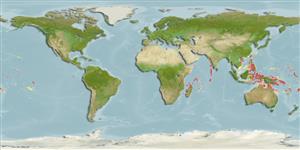Classification / Names
Common names from other countries
Main reference
Size / Weight / Age
Max length : 3.9 cm SL male/unsexed; (Ref. 9360)
Environment
Marine; reef-associated; non-migratory; depth range 8 - 30 m (Ref. 90102)
Climate / Range
Tropical, preferred ?
Distribution
Short description
Dorsal
spines
(total): 7;
Dorsal
soft rays
(total): 10;
Anal
spines: 1;
Anal
soft rays: 8. This species is distinguished by the following characters: no fraenum; lateral line scale series 28 or more; pectoral fin rays 20 or more; nape and body with 4 broad dark bars on a light background; anterodorsal region of the caudal fin with an ocellated eye-sized dark spot (Ref. 9018); characterized further by having a pair of bands below eye; large partially ocellated black spots on both dorsal fins; ctenoid body scales to level of second dorsal spine, cycloid anteriorly, including base of pectoral fin, breast and ventrally on abdomen; head and median part of nape without scales; side of nape to above middle of opercle with small embedded scales; cheek without vertical row of papillae; depth of body 4.1 in SL (Ref. 90102).
IUCN Red List Status (Ref. 115185)
Threat to humans
Harmless
Human uses
More information
Common namesSynonymsMetabolismPredatorsEcotoxicologyReproductionMaturitySpawningFecundityEggsEgg development
ReferencesAquacultureAquaculture profileStrainsGeneticsAllele frequenciesHeritabilityDiseasesProcessingMass conversion
Tools
Special reports
Download XML
Internet sources
Estimates of some properties based on models
Phylogenetic diversity index
PD50 = 0.5000 many relatives (e.g. carps) 0.5 - 2.0 few relatives (e.g. lungfishes)
Trophic Level
3.2 ±0.3 se; Based on size and trophs of closest relatives
Resilience
High, minimum population doubling time less than 15 months (Preliminary K or Fecundity.)
Vulnerability
Low vulnerability (11 of 100)
Price category
